Monitoring Litter Inputs from the Adour River (Southwest France) to the Marine Environment
Abstract
:1. Introduction
2. Materials and Methods
2.1. Study Site
2.2. Sampling Strategy & Litter Monitoring
2.3. Environmental Data Collection
2.4. Statistical Analyses
- A correspondence analysis (CA) was computed on normed density of litter per sampling site for each use category, i.e., the total number of collected litter items per sampling site were transformed in density (number of litter items/number of samplings/area of sampling site) and were then normed by dividing by the total number of litter items in each use category. The use category “unknown” was not included because it does not provide relevant information for this analysis. The CA was used to study how the relative litter compositions and origins differ between sampling sites.
- A canonical Redundancy Analysis (RDA) was applied to identify factors driving litter abundance on river banks. RDA is a constraint ordination method, which estimates linear relationships between components of response variables that are explained by a set of explanatory variables. Count density and mass density of litter were selected as response variables while normed mean water level, normed max water level, catchment area, population density and distance to the sea were selected as potential explanatory variables. This analysis was only performed for the six inland sites, because water level on La Barre beach and in the estuary is tide dependent. Variables were standardized in R using the decostand function (method = “max”) of the vegan package [20], as they are expressed with different orders of magnitude and on different measurement scales. The constrained and unconstrained variances were compared. A much higher constrained variance compared to the unconstrained variance means that some of the variation in the response data may be accounted for by the explanatory variables [21].
3. Results
4. Discussion
- (1)
- Food and beverages packaging, smoking related items, and common household items can be either thrown away because of incivility, involuntary loss, or mismanagement (discarded during collection operations or transport by local authorities). This litter category is mostly found in tourist areas and cities, close to “take-away” restaurants. Food packaging often consists of very fine plastics that fly away and break up very easily. Packaging ending up on city grounds are pushed by the wind and runoff to rainwater collection systems which take them either straight to the closest river or to the next Waste Water Treatment Plant (WWTP). Some packaging can also be directly discarded on the beach and can end up in the sea because of wind or tide rise. Cigarette butts are mostly thrown away due to incivility.
- (2)
- Fishery and mariculture gear are found in high numbers on La Barre beach and in the estuary, even though there is no intensive fishery activity in this area. This suggests that most litter related to this usage category travels from further areas and are lost at sea during storms. For instance, we found high quantities of rubber pieces on the beach that are used in mariculture.
- (3)
- Sewage related debris are mostly sanitary and medical products discarded in toilets. From there, they either reach the WWTP and end up in the sewage sludge or, in the case of combined networks and overload, end up directly into the environment via CSO.
- (4)
- Industrial packaging and construction debris are either dumped directly in the environment to avoid paying taxes, or lost during transportation. Most construction companies use dump trucks and do not cover bins before transportation on the road. Waste flies away and end up on roads before being damaged by cars. Small pieces are then carried by runoff to the nearest rainwater collection system.
- (5)
- Agricultural tarpaulin such as mulching film and packaging are occasionally discarded or forgotten on agricultural fields. Wind and floods carry them to the closest river.
- (6)
- Recreational fishing tackles are primarily found on La Barre beach and in the estuary. High recreational fishing activities occur in the estuaries, since those areas contain high volumes of fish. Windy conditions and rocky bottoms may make fishing activities difficult. Tackles are therefore more likely to be discarded or lost closer to the sea than inland.
5. Conclusions
Supplementary Materials
Acknowledgments
Author Contributions
Conflicts of Interest
References
- Hudson, A. Restoring and protecting the world’s large marine ecosystems: An engine for job creation and sustainable economic development. Environ. Dev. 2016, 22, 150–155. [Google Scholar] [CrossRef]
- Poloczanska, E.S.; Brown, C.J.; Sydeman, W.J.; Kiessling, W.; Schoeman, D.S.; Moore, P.J.; Brander, K.; Bruno, J.F.; Buckley, L.B.; Burrows, M.T.; et al. Global imprint of climate change on marine life. Nat. Clim. Chang. 2013, 3, 919–925. [Google Scholar] [CrossRef]
- Zaneveld, J.R.; Burkepile, D.E.; Shantz, A.A.; Pritchard, C.E.; McMinds, R.; Payet, J.P.; Welsh, R.; Correa, A.M.S.; Lemoine, N.P.; Rosales, S.; et al. Overfishing and nutrient pollution interact with temperature to disrupt coral reefs down to microbial scales. Nat. Commun. 2016, 7, 11833. [Google Scholar] [CrossRef] [PubMed]
- Woodall, L.C.; Sanchez-Vidal, A.; Canals, M.; Paterson, G.L.; Coppock, R.; Sleight, V.; Calafat, A.; Rogers, A.D.; Narayanaswamy, B.E.; Thompson, R.C. The deep sea is a major sink for microplastic debris. R. Soc. Open Sci. 2014, 1, 140317. [Google Scholar] [CrossRef] [PubMed]
- Gall, S.C.; Thompson, R.C. The impact of debris on marine life. Mar. Pollut. Bull. 2015, 92, 170–179. [Google Scholar] [CrossRef] [PubMed]
- Derraik, J.G. The pollution of the marine environment by plastic debris: a review. Mar. Pollut. Bull. 2002, 44, 842–852. [Google Scholar] [CrossRef]
- Van der Wal, M.; Van der Meulen, M.; Tweehuijsen, G.; Peterlin, M.; Palatinus, A.; Kovač Viršek, M. Identification and Assessment of Riverine Input of (Marine) Litter; IFREMER: Issy-les-Moulineaux, France, 2015. [Google Scholar]
- Lechner, A.; Keckeis, H.; Lumesberger-Loisl, F.; Zens, B.; Krusch, R.; Tritthart, M.; Glas, M.; Schludermann, E. The Danube so colourful: A potpourri of plastic litter outnumbers fish larvae in Europe’s second largest river. Environ. Pollut. 2014, 188, 177–181. [Google Scholar] [CrossRef] [PubMed]
- Lebreton, L.C.; van der Zwet, J.; Damsteeg, J.W.; Slat, B.; Andrady, A.; Reisser, J. River plastic emissions to the world’s oceans. Nat. Commun. 2017, 8, 15611. [Google Scholar] [CrossRef] [PubMed]
- Jambeck, J.R.; Geyer, R.; Wilcox, C.; Siegler, T.R.; Perryman, M.; Andrady, A.; Narayan, R.; Law, K.L. Plastic waste inputs from land into the ocean. Science 2015, 347, 768–771. [Google Scholar] [CrossRef] [PubMed]
- González, D.; Hanke, G.; Tweehuysen, G.; Bellert, B.; Holzhauer, M.; Palatinus, A.; Hohenblum, P.; Oosterbaan, L. Riverine Litter Monitoring—Options and Recommendations. MSFD GES TG Marine Litter; Joint Research Centre: Brussels, Belgium, 2016. [Google Scholar]
- OSPAR Commission. Guideline for Monitoring Marine litter on the Beaches in the OSPAR Maritime Area; OSPAR Commission: London, UK, 2010; p. 84. [Google Scholar]
- Galgani, F.; Leaute, J.P.; Moguedet, P.; Souplet, A.; Verin, Y.; Carpentier, A.; Goraguer, H.; Latrouite, D.; Andral, B.; Cadiou, Y.; et al. Litter on the sea floor along European coasts. Mar. Pollut. Bullet. 2000, 40, 516–527. [Google Scholar] [CrossRef]
- Adour-Garonne Basin Committee. Synthesis Update State of the SDAGE of 2016–2021; Adour-Garonne Basin Committee: Toulouse, France, 2013. [Google Scholar]
- CORINE Land Cover. CLC 2012. Available online: http://land.copernicus.eu/pan-european/corine-land-cover (accessed on 12 October 2017).
- Banque Hydro. Available online: http://www.hydro.eaufrance.fr/ (accessed on 10 August 2017).
- INSEE (Institut National de la Statistique et des Etudes Economiques). Available online: https://www.insee.fr (accessed on 14 August 2017).
- SIEAG (Système d’Information sur Eau du bassin Adour-Garonne). Available online: http://www.siaeag.fr/ (accessed on 14 August 2017).
- R: A Language and Environment for Statistical Computing. R Foundation for Statistical Computing; R Core Team: Vienna, Austria, 2014.
- Vegan: Community Ecology Package; R Package Version 2.4-5; Ordination Methods, Diversity Analysis and Other Functions for Community and Vegetation Ecologists; CRAN: Oulu, Finland, 2017.
- Legendre, P.; Legendre, L.F. Numerical Ecology; Elsevier: Oxford, UK, 2012. [Google Scholar]
- Dray, S.; Dufour, A.B. The ade4 package: Implementing the duality diagram for ecologists. J. Stat. Softw. 2007, 22, 1–20. [Google Scholar] [CrossRef]
- Morritt, D.; Stefanoudis, P.V.; Pearce, D.; Crimmen, O.A.; Clark, P.F. Plastic in the Thames: A river runs through it. Mar. Pollut. Bullet. 2014, 78, 196–200. [Google Scholar] [CrossRef] [PubMed]
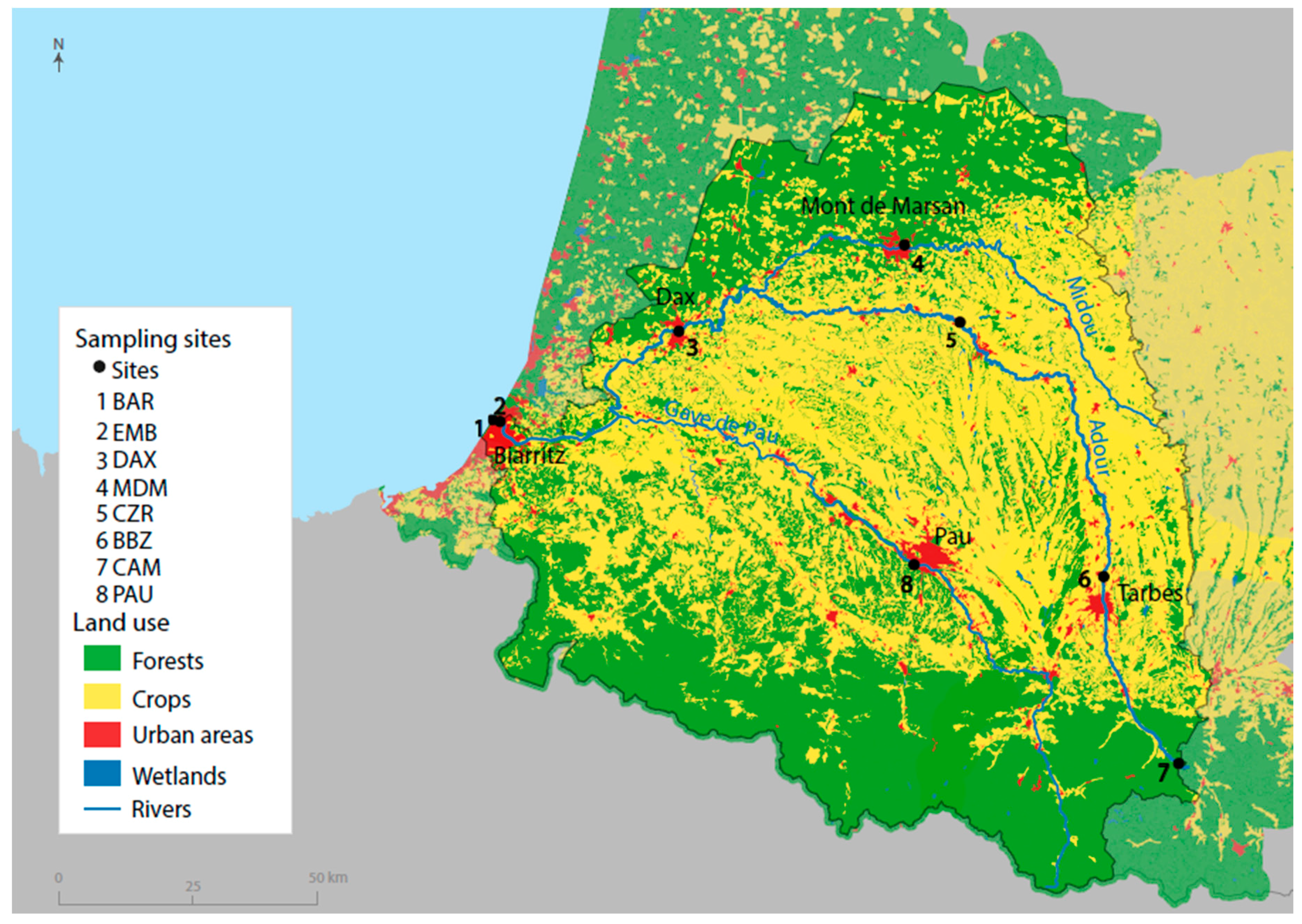
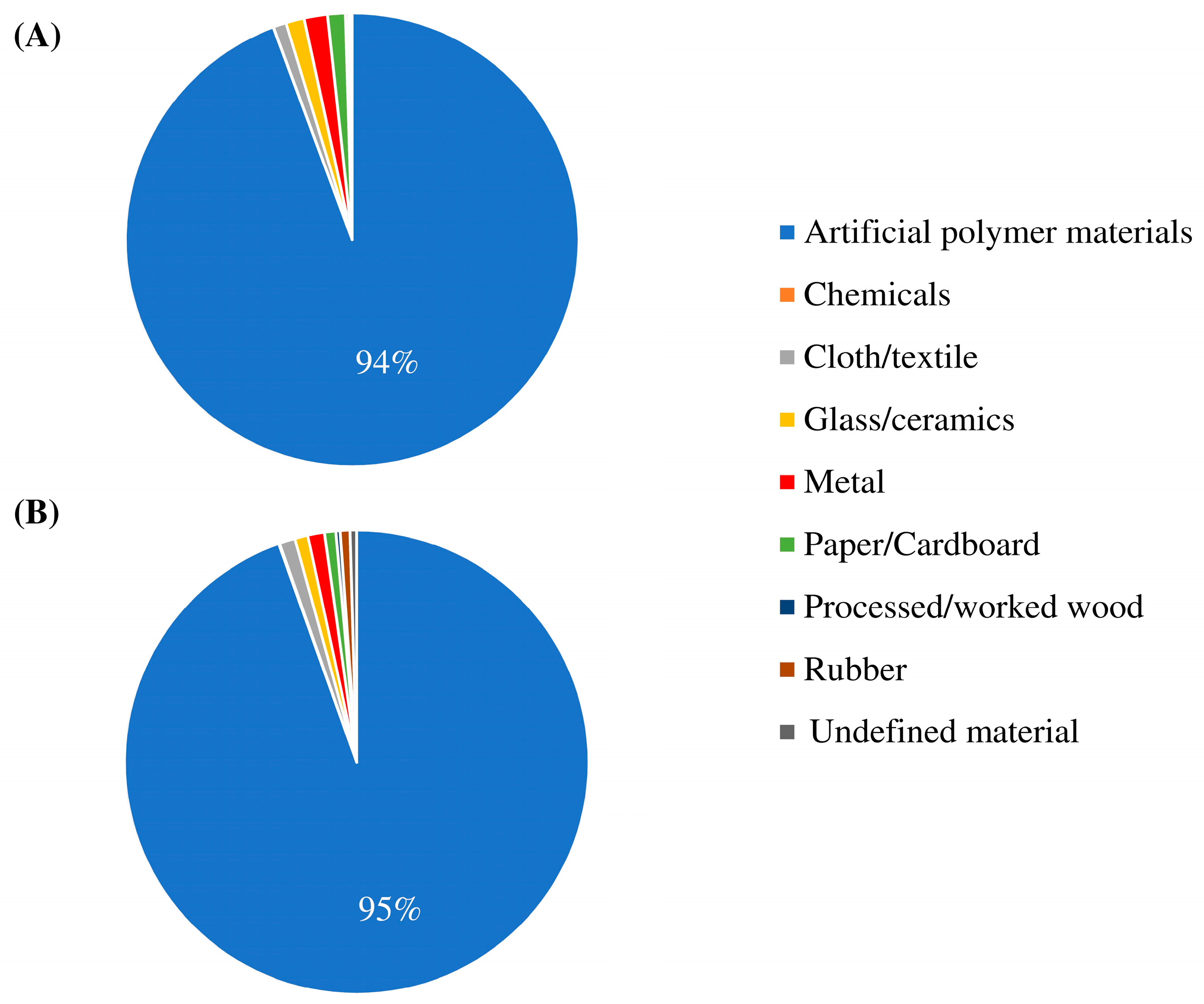
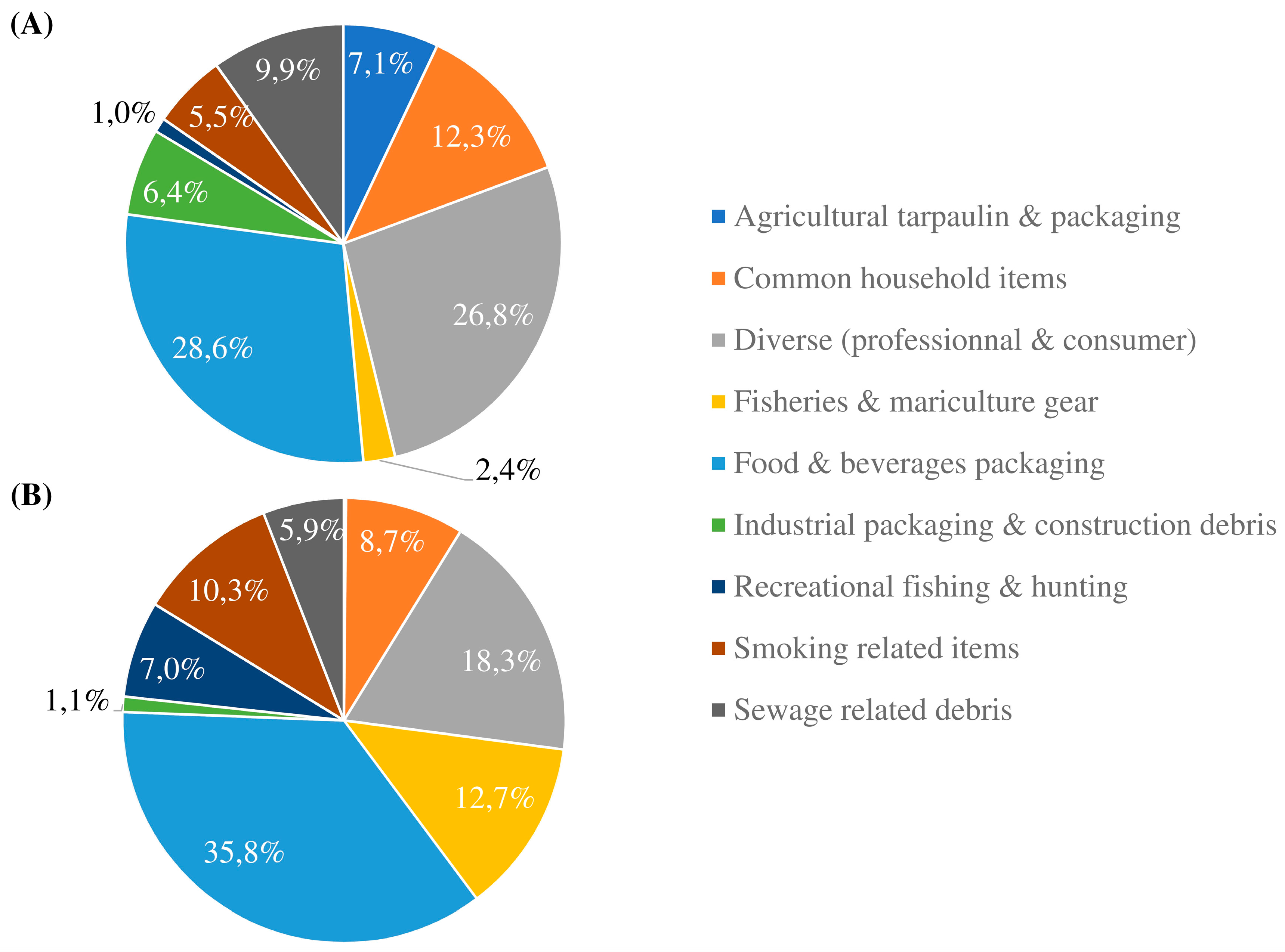
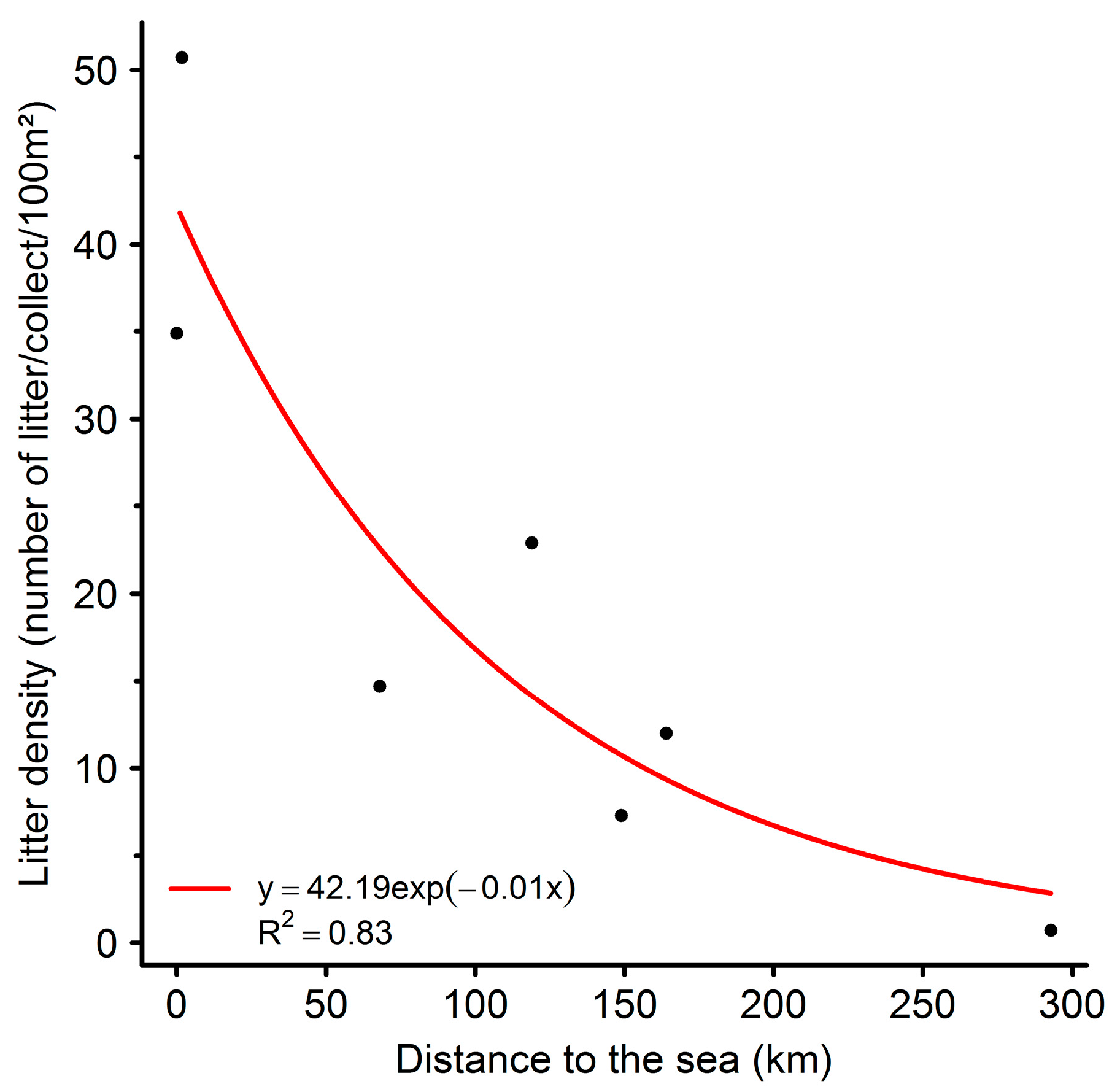
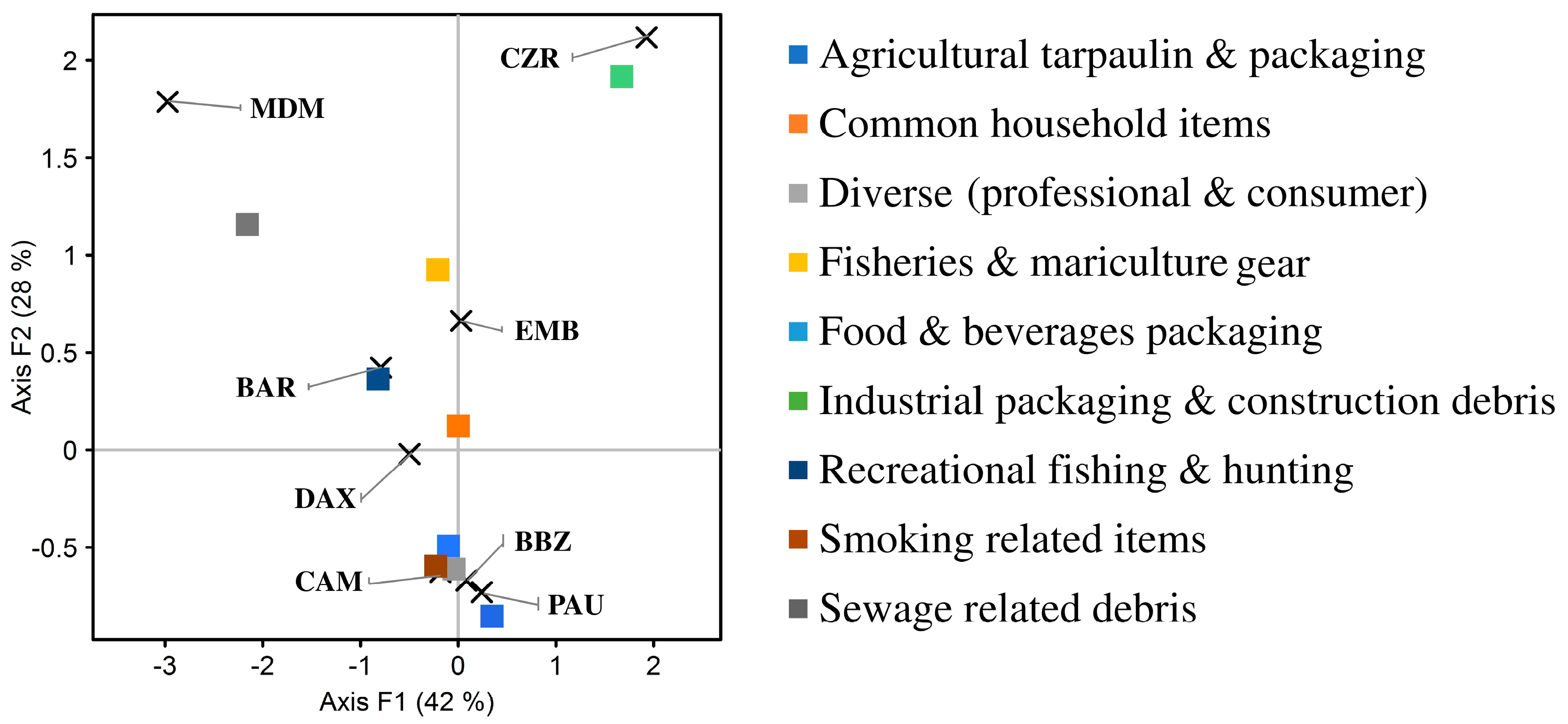
| Site | Abbr. | River or Tributary River | Average Surface (m2) | Coordinates (Decimal Degrees) | Main Type of Anthropogenic Pressure | Distance to the Sea (km) | Hydromophology |
|---|---|---|---|---|---|---|---|
| Campan | CAM | Adour | 366 | 42.93718/0.29376 | tourism | 293 | low slope, little riparian vegetation |
| Bours | BBZ | Adour | 84 | 43.28552/0.08281 | urban | 244 | low slope, well developed riparian vegetation |
| Pau | PAU | Gave de Pau | 268 | 43.29369/−0.40991 | urban | 119 | low slope, little riparian vegetation |
| Cazère-sur-l’Adour | CZR | Adour | 459 | 43.75682/−0.31715 | agriculture | 164 | medium slope, very dense riparian vegetation |
| Mont de Marsan | MDM | Midouze | 186 | 43.89868/−0.47107 | sewage station | 149 | strong slope, little riparian vegetation |
| Dax | DAX | Adour | 136 | 43.71484/−1.05039 | urban | 68 | steep slope, well developed riparian vegetation |
| Anglet | EMB | Adour | 2657 | 43.52569/−1.50326 | urban/harbor | 1.7 | medium slope, rocks without vegetation |
| La Barre Beach | BAR | - | 4750 | 43.52823/−1.52392 | urban/tourism, beach cleaned every day during summer and on a regular basis the rest of the year | - | - |
| Site | Number of Samplings | Number of Collected Items | Wet Mass (kg) | Litter Density (Items/Collection/100 m²) | Surface (m²) |
|---|---|---|---|---|---|
| CAM | 36 | 89 | 1 (for 29 samplings *) | 1 | 377 |
| BBZ | 39 | 16395 | 20 (for 32 samplings) | 400 | 105 |
| PAU | 31 | 1945 | 32 (for 31 samplings) | 27 | 231 |
| CZR | 38 | 1765 | 13 (for 31 samplings) | 20 | 229 |
| MDM | 31 | 675 | 21 (for 31 samplings) | 10 | 210 |
| DAX | 30 | 487 | 17 (for 30 samplings) | 9 | 176 |
| EMB | 35 | 39859 | 678 (for 30 samplings) | 43 | 2657 |
| BAR | 38 | 59417 | 167 (for 31 samplings) | 35 | 4426 |
| Total | 278 | 120632 | 949 | 5 | 8411 |
| Top | La Barre Beach | Inland Sampling Sites |
|---|---|---|
| 1 | Drink bottles | Crisps packets/sweets wrappers and lolly sticks |
| 2 | Cigarette butts and filters | Foam (insulation, packaging and foam) |
| 3 | String and cord (diameter less than 1 cm) | Food containers incl. fast food containers |
| 4 | Food containers incl. fast food containers | Plastic caps/lids |
| 5 | Fishing line/monofilament (angling) | Agricultural tarpaulin |
| 6 | Plastic caps/lids | Other sanitary items |
| 7 | Crisps packets/sweets wrappers and lolly sticks | Sheets, industrial packaging, plastic sheeting |
| 8 | Foam (insulation, packaging and foam) | Other glass items |
| 9 | Cotton bud sticks | Cigarette butts and filters |
| 10 | Cups and cup lids | Other textiles (incl. rags) |
| Variables | Inertia | Proportion (%) | Eigenvalues | |
|---|---|---|---|---|
| Dim. 1 | Dim. 2 | |||
| Total | 0.047 | 100 | ||
| Constrained axes | 0.010 | 20.4 | 0.008 | 0.002 |
| Unconstrained axes | 0.037 | 79.6 | 0.028 | 0.010 |
© 2018 by the authors. Licensee MDPI, Basel, Switzerland. This article is an open access article distributed under the terms and conditions of the Creative Commons Attribution (CC BY) license (http://creativecommons.org/licenses/by/4.0/).
Share and Cite
Bruge, A.; Barreau, C.; Carlot, J.; Collin, H.; Moreno, C.; Maison, P. Monitoring Litter Inputs from the Adour River (Southwest France) to the Marine Environment. J. Mar. Sci. Eng. 2018, 6, 24. https://doi.org/10.3390/jmse6010024
Bruge A, Barreau C, Carlot J, Collin H, Moreno C, Maison P. Monitoring Litter Inputs from the Adour River (Southwest France) to the Marine Environment. Journal of Marine Science and Engineering. 2018; 6(1):24. https://doi.org/10.3390/jmse6010024
Chicago/Turabian StyleBruge, Antoine, Cristina Barreau, Jérémy Carlot, Hélène Collin, Clément Moreno, and Philippe Maison. 2018. "Monitoring Litter Inputs from the Adour River (Southwest France) to the Marine Environment" Journal of Marine Science and Engineering 6, no. 1: 24. https://doi.org/10.3390/jmse6010024




